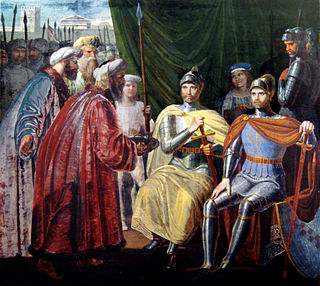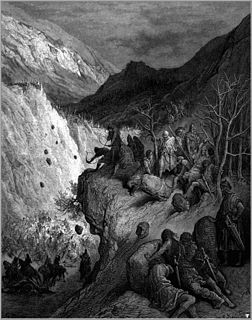Related Research Articles

Alp Arslan was the second Sultan of the Seljuk Empire and great-grandson of Seljuk, the eponymous founder of the dynasty. He greatly expanded the Seljuk territory and consolidated his power, defeating rivals to the south and northwest, and his victory over the Byzantines at the Battle of Manzikert, in 1071, ushered in the Turkoman settlement of Anatolia. For his military prowess and fighting skills, he obtained the name Alp Arslan, which means "Heroic Lion" in Turkish.
The 1090s was a decade of the Julian Calendar which began on January 1, 1090, and ended on December 31, 1099.
The 1070s was a decade of the Julian Calendar which began on January 1, 1070, and ended on December 31, 1079.
The 1060s was a decade of the Julian Calendar which began on January 1, 1060, and ended on December 31, 1069.
The 1100s was a decade of the Julian Calendar which began on January 1, 1100, and ended on December 31, 1109.

Year 1072 (MLXXII) was a leap year starting on Sunday of the Julian calendar, the 1072nd year of the Common Era (CE) and Anno Domini (AD) designations, the 72nd year of the 2nd millennium, the 72nd year of the 11th century, and the 3rd year of the 1070s decade.
The 1110s was a decade of the Julian Calendar which began on January 1, 1110, and ended on December 31, 1119.
The 1080s was a decade of the Julian Calendar which began on January 1, 1080, and ended on December 31, 1089.
Year 1118 (MCXVIII) was a common year starting on Tuesday of the Julian calendar.

Year 1068 (MLXVIII) was a leap year starting on Tuesday of the Julian calendar, the 1068th year of the Common Era (CE) and Anno Domini (AD) designations, the 68th year of the 2nd millennium, the 68th year of the 11th century, and the 9th year of the 1060s decade.

Year 1176 (MCLXXVI) was a leap year starting on Thursday of the Julian calendar.

Year 1059 (MLIX) was a common year starting on Friday of the Julian calendar, the 1059th year of the Common Era (CE) and Anno Domini (AD) designations, the 59th year of the 2nd millennium, the 59th year of the 11th century, and the 10th and last year of the 1050s decade.

Year 1064 (MLXIV) was a leap year starting on Thursday of the Julian calendar, the 1064th year of the Common Era (CE) and Anno Domini (AD) designations, the 64th year of the 2nd millennium, the 64th year of the 11th century, and the 5th year of the 1060s decade.

Year 1069 (MLXIX) was a common year starting on Thursday of the Julian calendar, the 1069th year of the Common Era (CE) and Anno Domini (AD) designations, the 69th year of the 2nd millennium, the 69th year of the 11th century, and the 10th and last year of the 1060s decade.

Year 1074 (MLXXIV) was a common year starting on Wednesday of the Julian calendar, the 1074th year of the Common Era (CE) and Anno Domini (AD) designations, the 74th year of the 2nd millennium, the 74th year of the 11th century, and the 5th year of the 1070s decade.

Romanos IV Diogenes, also known as Romanus IV, was a member of the Byzantine military aristocracy who, after his marriage to the widowed empress Eudokia Makrembolitissa, was crowned Byzantine Emperor and reigned from 1068 to 1071. During his reign he was determined to halt the decline of the Byzantine military and to stop Turkish incursions into the Byzantine Empire, but in 1071 he was captured and his army routed at the Battle of Manzikert. While still captive he was overthrown in a palace coup, and when released he was quickly defeated and detained by members of the Doukas family. In 1072, he was blinded and sent to a monastery, where he died of his wounds.

Michael VII Doukas, nicknamed Parapinakes, was Byzantine emperor from 1071 to 1078. He was known as incompetent as an emperor and reliant on court officials, especially of his finance minister Nikephoritzes, who increased taxation and luxury spending while not properly financing their army. Under his reign, Bari was lost and his empire faced open revolt in the Balkans. Along with the advancing Seljuk Turks in the eastern front, Michael also had to contend with his mercenaries openly going against the empire. Michael stepped down as emperor in 1078 where he later retired to a monastery.

The Battle of Manzikert or Battle of Malazgirt was fought between the Byzantine Empire and the Seljuk Empire on 26 August 1071 near Manzikert, theme of Iberia. The decisive defeat of the Byzantine army and the capture of the Emperor Romanos IV Diogenes played an important role in undermining Byzantine authority in Anatolia and Armenia, and allowed for the gradual Turkification of Anatolia. Many of the Turks, who had been travelling westward during the 11th century, saw the victory at Manzikert as an entrance to Asia Minor.

The Byzantine Empire was ruled by emperors of the Doukas dynasty between 1059 and 1081. There are six emperors and co-emperors of this period: the dynasty's founder, Emperor Constantine X Doukas, his brother John Doukas, katepano and later Caesar, Romanos IV Diogenes, Constantine's son Michael VII Doukas, Michael's son and co-emperor Constantine Doukas, and finally Nikephoros III Botaneiates, who claimed descent from the Phokas family.
Rashid al-Dawla Mahmud, full name Mahmud bin Shibl al-Dawla Nasr bin Salih bin Mirdas also known as Abu Salama Mahmud bin Nasr bin Salih, was the Mirdasid emir of Aleppo from 1060 to 1061 and again from 1065 until his death.
References
- ↑ Kleinhenz, Christopher (2010). Medieval Italy: an encyclopedia. New York: Routledge. p. 95. ISBN 978-0-415-93930-0.